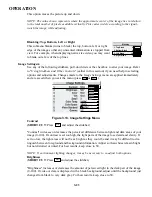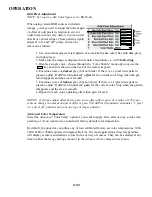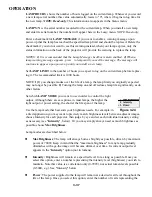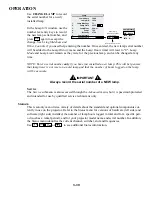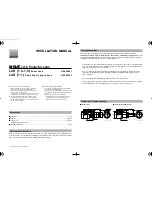
3-24
OPERATION
Color
(
SHORT CUT
: Press and adjust the slidebar.)
“Color” adjusts color saturation level, or the amount of color in a video image. For example,
setting Color to “0” produces a black and white image. If Color is set too high, the color levels
in the picture will be over-powering and unrealistic. Use or until the desired color
saturation level is displayed.
NOTE: COLOR is not available in the RGB mode.
Tint
(
SHORT CUT
: Press and adjust the slidebar.)
“Tint” adjusts color hue to obtain true color reproduction of NTSC video signals. Use or
until you reach optimum balance of red-to-green in your image. It is best to adjust tint
while displaying a proper SMPTE color bar test pattern-otherwise, it is recommended that tint
remain at its default setting.
NOTE: TINT is not available in the RGB mode.
Detail
(
SHORT CUT
: Press and adjust the slidebar.)
“Detail” adjusts the sharpness of the video image. Use or until the display is as
sharp as possible, keeping in mind that any level of detail above 3 (default) will increase the
level of detail as well as introduce some level of noise in the image. Set below 3 to filter the
signal and remove noise from a noisy source. Keep at 3 to apply no detail.
NOTE: DETAIL is
not available in the RGB mode.
Color Temp
“Color Temp” applies either a preset color temperature (3200K, 5400K, 6500K, 9300K) or any
previously defined Interpolated or custom “User” color temperature. All temperatures are meas-
ured in degrees Kelvin and represent the “coloration” (reddish or bluish) of the whites dis-
played by the projector-the lower the temperature, the more reddish the whites, the higher the
temperature, the more bluish the whites.
NOTE: Custom temperatures (“User” or “Interpolated”) can be defined in
the
Advanced Color Temperature
menu-until then, these choices all default to
6500K. See
Section 3.8, Adjusting System Parameters and Advanced
Controls
.
Color Space
This option determines how the color components of an input signal are decoded for accurate
color in the display. Selecting a color space option is useful only for analog signals connected
to
INPUT 1
or
INPUT 2
. Although the color space for such a signal is automatically deter-
mined by the projector, in some circumstances you may wish to override this and manually set
a different color space.
NOTE: For digital signals or for signals connected to
INPUT 3
or
INPUT 4
, the color space
function is entirely automatic and the pull-down list disabled.
Color
Tint
1. 3200K
2. 5400K
3. 6500K
4. 9300K
5. User1
6. User2
7. User3
8. User4
9. Interpolated
Detail
Summary of Contents for Reflection VX-3C
Page 2: ......
Page 119: ...B 1 KEYPAD REFERENCE Figure B 1 Keypad Appendix B ...
Page 120: ...C 1 Menu Tree Appendix C ...
Page 121: ...C 2 MENU TREE ...
Page 123: ...D 2 THROW DISTANCE ...
Page 124: ...D 3 THROW DISTANCE ...
Page 125: ...D 4 THROW DISTANCE ...
Page 126: ...D 5 THROW DISTANCE ...
Page 127: ...D 6 THROW DISTANCE ...
Page 128: ......
Page 129: ...2900 Faber Street Union City CA 94587 510 324 7777 Fax 510 324 9300 RUMA 003300 rev 9 00 ...














